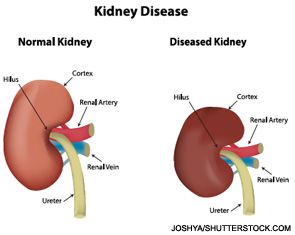Fifteen days after discharge, his serum calcium was low again, at 6.7, but the patient was asymptomatic. Calcium carbonate was increased to 3,000 mg four times per day, and calcitriol was changed to 0.25 mg twice daily. A week later, his calcium level normalized (8.5 mg/dL), PTH remained elevated (169 pg/mL) and 25 (OH) vitamin D was 21.7. A urine N–telopeptide was 21 BCE/nmol creatinine (normal adult male 9–60 BCE/nmol creatinine). Calcium carbonate was decreased to 1,500 mg four times per day.
Three weeks later, the serum calcium was 12.0, and the PTH was suppressed, at a value of 7 pg/mL. Calcitriol and calcium supplements were held. After another week, the serum calcium level normalized to 8.4 mg/dL with a PTH of 103 pg/mL. Calcitriol was restarted at 0.25 mg/day, with calcium carbonate at 1,500 mg twice daily.

Almost four months after initial injection, the patient became symptomatic and required hospitalization for hypocalcemia (calcium 5.9 mg/dL). He was treated with IV calcium. On Day 6, he was discharged with a normal calcium level and continued on calcium carbonate 3,000 mg/day and calcitriol 0.25 daily. Two weeks later, the serum calcium was 7.8, which required another calcium supplement adjustment. One month later, the serum calcium level increased to 8.2 mg/dL. By the end of the fifth month after injection, the serum calcium had improved. Over the next month, the patient had mild variations in the calcium level and has remained stable since on 750 mg of calcium carbonate twice a day and calcitriol 0.25 mg/day (see Table 1).
Discussion
Our case demonstrates a patient with severe symptomatic persistent hypocalcemia following a single injection of denosumab. Hypocalcemia persisted for nearly six months and required aggressive monitoring and treatment. To our knowledge, this is the longest post-denosumab-related hypocalcemia reported in the literature. During this period, the patient required two hospitalizations, IV calcium and adjustment of the oral calcium/calcitriol dose due to an unstable serum calcium level. Despite the fact that the patient was on calcium and vitamin D supplements and had a normal calcium level before denosumab administration, he developed severe persistent hypocalcemia.
The proposed mechanism for hypocalcemia developing following a denosumab injection is similar to hungry bone syndrome.
A pharmacokinetic study showed that the maximum denosumab concentration (T max) occurred on Day 10 and was independent of renal function.2,3 This correlates with the onset of our patient’s symptoms. Denosumab remains available for up to six months, which may explain the persistent hypocalcemia. The proposed mechanism for hypocalcemia developing following a denosumab injection is similar to hungry bone syndrome.3 Denosumab locks calcium in the bone by inhibiting osteoclasts, but calcium deposition into a new matrix is not affected. Thus, the serum calcium level could fall unless patients have adequate Ca/vitamin D supplementation.


